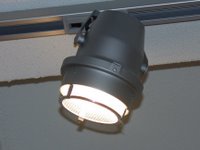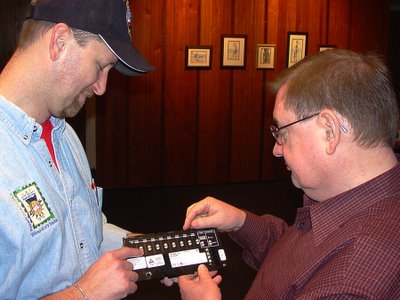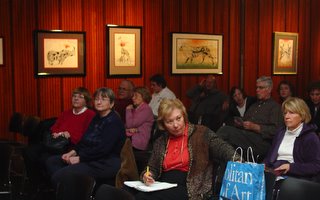Attendees at a Literacy Volunteers of America seminar on immigration law got a sneak preview of the lighting on Tuesday evening.
 "We spent several days tweaking the system," said library director Joe Da Rold, "to ensure that every light is optimized."
"We spent several days tweaking the system," said library director Joe Da Rold, "to ensure that every light is optimized."The lighting is run from a state-of-the-art panel in the projection booth at the rear of the room, with four preset configurations, ranging from fully lit to dim lighting to accommodate films and PowerPoint presentations. The presets can be operated from a remote control that resembles an ordinary TV remote.
The difference in the room is breathtakingly dramatic.
 The Anne Louise Davis Community Room is a popular and attractive meeting and exhibit space that has been used constantly for more than forty years. But the lighting previously left much to be desired. The canister lights, though classic '60s style, were not up to the task of providing ample, focused light on pieces mounted on the warm wood-panelled walls.
The Anne Louise Davis Community Room is a popular and attractive meeting and exhibit space that has been used constantly for more than forty years. But the lighting previously left much to be desired. The canister lights, though classic '60s style, were not up to the task of providing ample, focused light on pieces mounted on the warm wood-panelled walls.In addition, the focus on the walls left the impression that the meeting room itself was quite a bit darker, so that attendees at events where there were handouts were often seen squinting to read their materials.
With grant monies, Da Rold was able to bring the lighting situation into the 21st century by installing metal halide lamps on specially designed tracks. Mounting the tracks presented something of a challenge as they are fixed to the coffered ceiling of the room, which in reality is a 24-inch thick concrete structural support for the floor above.
 Library Director Joe Da Rold and Chief Technology Officer
Library Director Joe Da Rold and Chief Technology OfficerPeter Rejcevic examine the control module for the new system
Though metal halide lamps are more expensive than incandescent, they draw far less energy for their light output and last hundreds of times as long as regular bulbs, according to PSE&G, which regularly conducts lighting audits for public buildings, nonprofits and businesses.
-- Dan Damon
Keywords: Library, technology
*

No comments:
Post a Comment